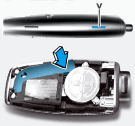How to Open a Volkswagen or Audi with a Dead Key Fob First, if you are already inside, click here for help getting an Audi started and here for a Volkswagon! Second, for video help, click here! Finally, if you need another manufacturer, click here. Retrieving the mechanical key There are three general styles of …
Tag: push button start
Permanent link to this article: https://dashboardsymbols.com/2012/04/volkswagen-and-audi-dead-key-fob-help/
Open a Hyundai with a Dead Key Fob
How to Open a Hyundai with a Dead Key Fob First, if you are already inside, click here for help getting started! Second, you can find video help here! Finally, if you need or want another manufacturer, click here. Retrieving the mechanical key Hyundai has used a flip key key fob since 2015 and they …
Permanent link to this article: https://dashboardsymbols.com/2012/04/hyundai-and-kia-dead-fob-help/
Open Chevrolet Models with a Dead Key Fob
How to Open Chevrolet Models with a Dead Key Fob First, if you are already inside, click here for help getting started! Second, you can find video help here! Finally, if you need another manufacturer, click here. Retrieving the mechanical key GM makes three key fob (remote control or ‘clicker’) styles, and Chevrolet uses them all. …
Permanent link to this article: https://dashboardsymbols.com/2012/04/general-motors-dead-fob-help/
Open a Ford with a Dead Key Fob
How to Open a Ford with a Dead Key Fob First, if you’re already inside, click here for help getting started! Second, Lincoln models are here. Third, you can find video help here! Finally, if you need another manufacturer, click here. Retrieving the mechanical key Ford vehicles use a number of different Intelligent Access (IA) (remote …
Permanent link to this article: https://dashboardsymbols.com/2012/04/ford-lincoln-dead-fob-help/
Open a Chrysler, Dodge or Ram with a Dead Key Fob
How to Open a Chrysler, Dodge or Ram with a Dead Key Fob First, if you are already inside, click here for help getting started! Second, for video help, click here! Finally, if you need another manufacturer, click here. Retrieving the mechanical key To remove the emergency (mechanical) key from a key fob belonging to …
Permanent link to this article: https://dashboardsymbols.com/2012/04/chrysler-dodge-dead-fob-help/





